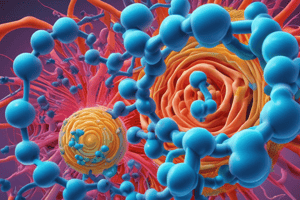Podcast
Questions and Answers
What is the operation of making a cone-shaped enlargement of the end of a hole for a flat head screw called?
What is the operation of making a cone-shaped enlargement of the end of a hole for a flat head screw called?
- Reaming
- Squaring
- Knurling
- Counter sinking (correct)
Which operation uses a cutting tool with several cutting edges to size and finish a hole?
Which operation uses a cutting tool with several cutting edges to size and finish a hole?
- Reaming (correct)
- Notching
- Piercing
- Turning
What term describes the process of marking center points and straight lines on metal surfaces for guidance?
What term describes the process of marking center points and straight lines on metal surfaces for guidance?
- Notching
- Hobbing
- Shaping
- Laying out (correct)
What device is used to align and test the trueness of machine tools and fixtures?
What device is used to align and test the trueness of machine tools and fixtures?
Which process involves the formation of metals using dies after heating them to their plastic range?
Which process involves the formation of metals using dies after heating them to their plastic range?
What term describes the distance a helical gear would thread along its axis in one revolution?
What term describes the distance a helical gear would thread along its axis in one revolution?
Which property of a material allows it to absorb energy when deformed elastically and return to its original shape when unloaded?
Which property of a material allows it to absorb energy when deformed elastically and return to its original shape when unloaded?
What is the name of the weld made to hold parts in alignment until the final welds are made?
What is the name of the weld made to hold parts in alignment until the final welds are made?
Which machine tool uses an abrasive wheel as a cutting tool to achieve a very smooth finish?
Which machine tool uses an abrasive wheel as a cutting tool to achieve a very smooth finish?
What do you call the machine tool used to produce various surfaces with a circular cutter that has multiple teeth?
What do you call the machine tool used to produce various surfaces with a circular cutter that has multiple teeth?
Flashcards are hidden until you start studying
Study Notes
Helical Gears and Mechanics
- Lead refers to the axial distance a helical gear would travel during one revolution if it could move freely.
Materials and Energy Absorption
- Resilience is the ability of a material to absorb energy during elastic deformation and return to its original shape upon unloading.
Welding Techniques
- A tack weld is a temporary weld that holds parts of a weldment in alignment until the final welds are executed.
Testing Machines
- The Rockwell test is used for testing very thin steel or surface layers.
Machine Tools
- A tool grinder utilizes an abrasive wheel as a cutting tool for achieving a smooth finish.
- A milling machine produces various surfaces using a circular cutter with multiple teeth.
- A broaching machine finishes internal and external surfaces with a series of cutting edges.
- A slotter machine is similar to a shaper but operates with a vertically reciprocating ram.
Workholding Devices
- A universal chuck is not recommended for applications requiring high accuracy.
- A mandrel aids in providing a center to turn or machine workpieces.
Machining Operations
- Counter sinking enlarges the end of a hole to create a recess for a flat-headed screw.
- Reaming is the process of sizing and finishing a hole with a multi-edged cutting tool.
Measurement and Calibration
- A dial indicator is used for testing the trueness of finished work and comparing various measurements.
- Plug gauges are implemented to measure cylindrical bores.
Casting and Molding
- Riser provides a reservoir for molten metal to ensure the casting feeds during solidification.
- In the Carthias process, metal is forced into the cavity using a core or plunger.
Tool Characteristics
- The usual helix angle for drills is around 30 degrees.
- Feeder mechanisms for lathe machines are typically expressed in mm per revolution.
Manufacturing Practices
- Rapping allowance in patterns compensates for easy withdrawal during the casting process.
- A burrowing feed applied to a lathe machine is defined as mm per revolution.
Files and Finishing Techniques
- A knife file is recommended for finishing sharp corners or grooves.
- Short, quick strokes with a file can result in flat surfaces on the finished piece, while long, slow strokes yield a better finish.
- Draw-filing is an effective method for achieving a smooth finish on metal surfaces.
Hacksaw Operations
- The best hacksaw blade for cutting thin wall tubing has a high teeth per inch (TPI) count.
- Coolants are essential in power hacksaws to absorb heat and prevent blade overheating.
General Tool Usage Tips
- Always use files with a handle; never employ dirty files.
- When cutting long, thin pieces, the hacksaw blade should be turned at right angles to the frame for optimal performance.
- The arrangement of teeth on a hacksaw blade should always face forward in the frame.
Studying That Suits You
Use AI to generate personalized quizzes and flashcards to suit your learning preferences.




